Where and how to plant zucchini for seedlings correctly: instructions from seed preparation to transplanting young animals to the site
There are zucchini in almost every summer cottage. This low calorie vegetable contains a lot of nutrients and useful substances. The product is subjected to heat treatment, less often it is eaten raw. The culture is grown from both seeds and seedlings. In addition to feeding and watering, the vegetable does not need special care, but growth control is needed, like any other crop.
From the article you will learn how to properly plant zucchini on seedlings in order to get a bountiful and high-quality harvest.
The content of the article
- Why you should choose planting with seedlings
- What you need to grow seedlings
- Seedling planting rules
- Presowing seed treatment
- Conditions before germination of zucchini seeds
- Soil preparation
- The procedure for sowing seeds for seedlings
- Lighting and temperature for growing seedlings on the windowsill
- Watering and humidity
- Dates of planting seedlings in open ground
- Care of young zucchini plants
- Attempted seedlings, what to do?
- Possible problems when growing seedlings
- Planting zucchini for seedlings in a non-standard way
- When can you plant seedlings in open ground
- Conclusion
Why you should choose planting with seedlings
Zucchini ripens very quickly, which is why the method of planting with the help of seeds is chosen if they do not want to get a harvest too early, for example, wanting to combine the collection of fruits with other vegetables.
However, planting zucchini with seedlings is an equally popular method, which is chosen due to its advantages: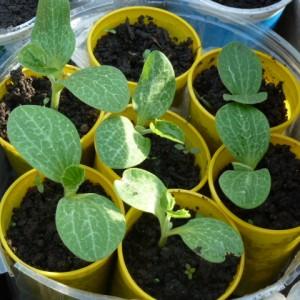
- Getting an early harvest. Already in June, you can feast on your favorite vegetable.
- Using the seedling planting method, you can easily calculate the exact number of plants. When planting with seeds, you cannot be completely sure of this (some grains may not sprout).
- Correctly planted seedlings will allow you to get strong zucchini that grow quickly, bear fruit well and are practically not susceptible to disease.
- The method allows you to get a harvest even in cold regions, where freezing temperatures are established in April-May.
What you need to grow seedlings
How to grow marrow seedlings in order to get a good harvest in the future? It's simple - stick to basic guidelines.
Preparatory work is carried out in several stages. But only with strict adherence to the technology can you be sure of the expected result.
Selecting seeds for planting
It is better to select seeds in advance so that everything is ready by the time of planting. Some gardeners try to combine several varieties with different ripening times in order to get a harvest throughout the season.
Important! Choose seeds with a shelf life of 2 to 4 years. If you take fresh grains, the harvest will not be as high quality due to the formation of male flowers.
The seeds need sorting. The event involves a test of seed material for germination. To do this, they are placed in a saline solution for an hour (30 g of salt per 1 liter of water). During this time, seeds suitable for planting will sink to the bottom, empty ones will float up. All that remains is to rinse the seed with clean water.
Choosing a container for young growth
Zucchini seedlings are sensitive to transplanting, so each zucchini must be planted in separate containers.
Suitable containers:
- plastic or peat cups;
- cut bottles with perforated bottom;
- plastic containers;
- packaging from juice or yogurt.
On a note... The volume of the selected container must be at least 0.5 liters.
Seedling planting rules
Planting zucchini seeds for seedlings is one of the fundamental points in growing a crop. It is at this stage that it is important to do everything right in order to eventually get a high-quality harvest on time. Before planting, the seeds must be treated with antifungal and nutrient solutions.
Presowing seed treatment
Initially, the seed is inspected for damage. Sick, spoiled or for other reasons unsuitable for sowing grain must be thrown away.
Zucchini seeds from retail chains are usually already prepared and do not require any additional processing and sorting..
Hand-bought or homemade grains must be disinfected: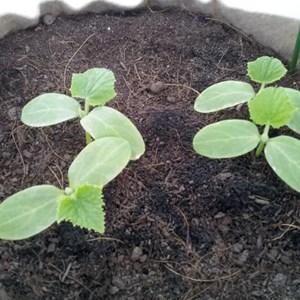
- Soak the seed for 5 hours in water at 50 ° C temperature.
- Then put the seeds in cold water for a few minutes.
There is another method of pre-sowing antifungal seed treatment: make a low-borne solution of potassium permanganate and keep the grains in it for about 20 minutes.
The seed can also be treated with aloe juice and left to warm in the sun for several days. For etching often use the drug "Fitosporin-M".
Conditions before germination of zucchini seeds
In the early days, the plant requires a low temperature and bright, but diffused lighting. It will be enough to place the seedlings on a windowsill or in a greenhouse.
Care in the first month consists mainly in watering, feeding and observing light and temperature conditions.
Soil preparation
Before using the soil for planting zucchini, you need to check its acidity level. A neutral or slightly alkaline reaction is ideal.
For self-preparation of the soil, mix:
- peat soil - 5 kg;
- turf - 2 kg;
- humus - 2 kg;
- sawdust - 1 kg.
If the soil is too acidic, stir it with chalk or ash.
A store-bought ready-to-use mixture for vegetable seedlings is also an excellent option. There are special soils for pumpkin crops on sale.
Read also:
What and how to store zucchini for a long time - we create ideal conditions.
How to cook delicious crispy lightly salted zucchini in a bag.
We save the harvest until spring: how to store zucchini for the winter correctly.
The procedure for sowing seeds for seedlings
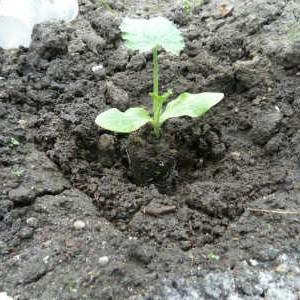 Before sowing, homemade seeds are soaked until they swell. Swollen grains can be stored in the refrigerator. If they germinate, they will sprout faster, but it must be borne in mind that the seedlings of zucchini are very thin, they must be handled carefully and such seeds should be planted immediately.
Before sowing, homemade seeds are soaked until they swell. Swollen grains can be stored in the refrigerator. If they germinate, they will sprout faster, but it must be borne in mind that the seedlings of zucchini are very thin, they must be handled carefully and such seeds should be planted immediately.
Wrap the finished processed seeds in a damp cloth and a plastic bag, put in a warm place and provide ventilation, airing several times a day. The fabric should not dry out or be too damp.
Planting seeds:
- fill prepared containers with soil;
- water the soil abundantly with warm water;
- place grains 2.5-3 cm deep in the ground;
- cover the seedlings with glass or foil.
It is better to plant zucchini seeds for seedlings in pairs: 2 grains in one container.
Important! Peat pots - biodegradable disposable container for seedlings. Plants can be planted in open ground directly in a pot, which, in the process of decay, will become an additional fertilizer for the crop.
Lighting and temperature for growing seedlings on the windowsill
The optimum temperature for the growth of zucchini is 20-25 ºС, but they feel good even at 15-20 ºС. Therefore, when growing seedlings at home, it makes no sense to think too much about the temperature.
Important! Make sure it is not too hot in the first 4-5 days after germination. For this period, it is better to determine the seedlings on the coldest windowsill.
Diffused lighting is preferred. Daylight hours for seedlings should be more than 12 hours. If the seedlings are placed on the south side, then the plants will not need additional lighting.
When placing seedlings on the north side, it is recommended to place a phytolamp or a cold-glow fluorescent lamp above them. Incandescent lamps heat up the air too much and burn the plants.
Watering and humidity
Water the squash seedlings with warm water only. Make sure that the soil never dries out.
Note! Excess moisture is no less harmful. It can cause root rot and seedling death.
We water the seedlings every 3-5 days on average. For each container with small sprouts, no more than 50 ml of water is used, when the seedlings grow up - 100 ml each.
In addition to soil moisture, air humidity is also important, which should not be too high. Do not allow neighboring plants to interfere with each other and moist air stagnate in the plantings. The cups with seedlings must be moved away from each other at such a distance in time so that the leaves of neighboring bushes do not come into contact with each other.
Dates of planting seedlings in open ground
Planting zucchini for seedlings depends on the climatic conditions of the region and is carried out from mid-March to mid-May. After 25-30 days, the seedlings will be ready for planting in open ground. Plants are transplanted to the garden from late May to mid-June. If planted later, the zucchini will not have time to ripen.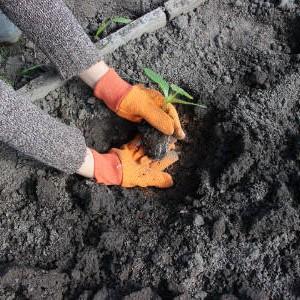
In central Russia, zucchini seeds are sown for seedlings at the following times:
- to get an early harvest - from April 20 to May 12-16;
- for conservation and long-term storage - from 14 to 30 July.
To correctly determine the time of planting zucchini for seedlings in any region, you need to inquire about the estimated air temperature for the next month.
Care of young zucchini plants
During the growing season, stretches already growing independently in the open field are carried out no more than 3 fertilizing with minerals. It is important not to overdo it with the use of nitrogen: otherwise, all the forces will go to the tops, and not to the ovary.
Watering conditions:
- During the summer, seedlings should be watered as needed, when from strong daytime evaporation and lack of moisture in the soil by the evening the leaf plates wither and sag.
- Water for irrigation must be warm, heated during the day in the sun.
- Watering should be done so as to wet the soil to almost the entire depth of root penetration, that is, at least 30-40 cm.
With a lack of moisture, the fruits grow medium-sized, but more sugary.
Attempted seedlings, what to do?
The main pest of zucchini is slugs. They are capable of destroying all seedlings in one night. Protect plants with regular ash or special granules that are scattered around the seedlings.
To save the plants from the bear, use tubes from cut plastic bottles 10-15 cm long. They are put on the plant so that the part of the root system, which is located directly under the earth's crust, is protected.
There may be small pests in the seedling soil. Therefore, before planting zucchini seeds for seedlings, it is necessary to disinfect the soil with a hot solution of potassium permanganate or use special preparations.
Possible problems when growing seedlings
If you strictly follow the rules for growing seedlings, there should be no problems.
Nevertheless, no one is immune from failure, and the gardener sometimes faces the following points:
- Seeds do not sprout... If the seedlings did not appear on the tenth day after sowing, there is no need to wait any longer: the seeds that hatched at this time would have sprouted long ago. Suitable seeds will germinate in moist soil at room temperature. We urgently need to buy or prepare new ones and reseeding.
 High seedling... A common problem for gardeners is too elongated sprouts. The reasons are different - high temperature, low illumination, cramped arrangement of the cups. Eliminate all the flaws: transplant seedlings into spacious pots, add light.
High seedling... A common problem for gardeners is too elongated sprouts. The reasons are different - high temperature, low illumination, cramped arrangement of the cups. Eliminate all the flaws: transplant seedlings into spacious pots, add light.- Seedlings grow slowly... This means poor quality soil was used: room temperature is ideal for normal growth. In dry soil, the plant can get stuck. To help the culture, zucchini should be fed with mineral fertilizers.
- Saplings wither. Excess moisture can cause seedlings to wilt. When overflowing with cold water, root rot is often formed. As a result, the tips of the roots die off, and the root collar begins to turn brown.
If there is a lack of nitrogen in the soil, the leaves may turn yellow. Leaves begin to deteriorate from the edge of the leaf, then the yellowness passes to the entire surface.
If you realized right away and fed the seedlings with a solution of urea or saltpeter, there is hope for recovery. If the leaves turn yellow entirely, the seedlings will die.
Planting zucchini for seedlings in a non-standard way
A non-standard method of growing squash seedlings is to use a wooden barrel. If you choose this method, you should pay attention to the average summer temperature in your area.
If it exceeds +30 ºС, the barrel is installed on the northern side of the site, where it will be cooler. If it is often cloudy in your area, place the container on the south side.
Next, we fill the barrel with the substrate. A couple of days before planting the seeds, the mixture must be abundantly moistened with a bucket of water.
For growing zucchini in a barrel, the following varieties are best suited: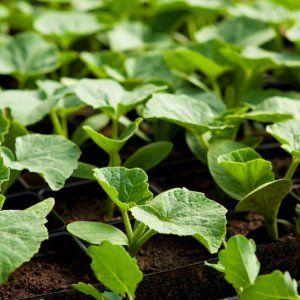
- Long-fruited;
- Apollo F1;
- Gribovsky 37;
- White-fruited;
- Sosnovsky;
- Pharaoh.
Planting seedlings in the ground is carried out when the mixture in the barrel warms up enough. As a rule, this happens in the second half of May.
For the successful cultivation of zucchini in a barrel, it is necessary to loosen the soil in a timely manner, cut off excess leaves and, if possible, help insects in pollination of flowers.
It is recommended to fertilize plants for the first time a week after planting in the ground. To do this, mix 5 g of superphosphate, 10 g of urea, 3 g of ammonium and the same amount of magnesium. Dissolve the mixture in a bucket of water. Processing is carried out with the calculation of 1 liter of composition for one seedling.
During fruiting, standard complex fertilizers for pumpkin plants are used to feed zucchini. Their dosage is individual, usually indicated on the package.
When can you plant seedlings in open ground
Monitor the air temperature. When the average daily temperature is 15 ° C, plant the squash seedlings in open ground.
Signs of sprout readiness:
- the seedlings have several dark green leaves,
- the root system covers the entire volume of the container,
- the roots themselves are strong, white.
Conclusion
If you want to get an excellent harvest from your grown squash seedlings, you should consider the climatic conditions in your region. Therefore, choose varieties of zucchini suitable for a particular climate.
Hybrid species with specially bred characteristics help out. A short summer involves harvesting from early varieties, if the heat lasts longer, medium varieties will do.